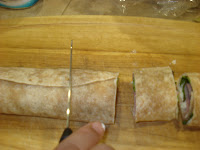
I have been trying to steam for a long time now, and only just this year have I gotten really into it. This started when one of the Asian food stores near where we live opened. I saw this beautiful bamboo steamer. It was a two-decker, about 7 -8 inches in diameter. I have been wanting to steam veggies and I have seen some of the Chinese restaurants that my family have been to use a bamboo steamer, especially when serving dim sum. So, instead of buying an aluminum or stainless steel steamer, I opted to buy a bamboo steamer. The price was a bit high for that size, I paid $22.95 plus tax.
I started cooking pork siomai and small pork dumplings. They were great! Unfortunately, I can only cook enough for my husband, daughter, and I. When we entertained, I wanted to steam more. Needless to say, there was a long wait for the seconds and thirds that my husband's family and some guests patiently waited for. I have decided since then that I needed a bigger one, which is why I got a much bigger bamboo steamer from San Francisco's Chinatown. I actually paid half the price of what I paid for the small one. Tell you how much they jack up prices when you are farther from the city.
I have been using the big steamer to steam "puto" (Filipino rice cakes), dumplings, siomais, vegetables, and fish. In this section, I will share with you my steamer recipes. Enjoy!
Steamed Fish with Ginger and Rice Wine

Ingredients:
2 pcs medium size fresh or frozen fillet fish (cod or catfish)
1 tsp ground black pepper
1 tsp garlic salt
1 tsp onion powder
1 cup soy sauce
2 Tbsp rice wine
1/2 cup ginger (sliced in julienne)
1/2 cup scallions (green onion leaves)
Aluminum foil to wrap fish.
Instructions:
In a shallow tray, place 2 pieces of fresh or frozen fillet fish (cod or catfish). Rub on ground pepper, garlic salt, and onion powder top and bottom. Set aside.
In a small bowl, mix soy sauce and rice wind.
Place water in a wok or boiler and bring it to a boil. The water should reach only midway.
Get a foil and place the fish and pour in the soy sauce and rice wine mixture. Note: use one foil per fish.
Drop the ginger and scallion on top of the fish before wrapping the foil. Close the foil and place inside the bamboo steamer.
Steam for 10 minutes or until done.
Serve with steamed rice or noodles.

 Grilled pork with A-1 Sauce. Grilled indoors using a cast-iron griller I bought from Williams & Sonoma. Caveat: the house can be filled with smoke even when the range hood is in full blast. The solution...see below- a smokeless griller.
Grilled pork with A-1 Sauce. Grilled indoors using a cast-iron griller I bought from Williams & Sonoma. Caveat: the house can be filled with smoke even when the range hood is in full blast. The solution...see below- a smokeless griller.
















